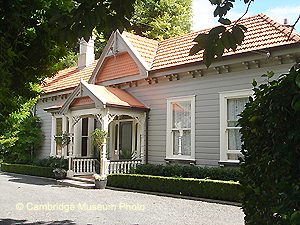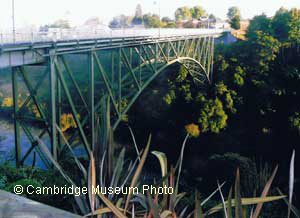Cambridge Town
Learn about the history of town and its districts, schools and roads over the years.
View moreA List Historic Buildings

The Cambridge Historic Buildings appearing on the ‘A’ List are set out here alphabetically and the bracketed numbers relate to their position in the Waipa District Council Plan – Appendix 10.
Researched and written by Eris Parker
Ref: Cambridge Museum Archives
80) 32 Alpha Street House
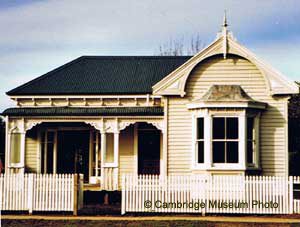
This house is an early 1900s small, single gable, colonial villa with a bay bow double-hung window with a shingle panel. The verandah has a bull nose roof, square posts with ornate fan shaped fretwork.
The soldier of the 3rd Waikato Militia who was granted this one acre section was Samuel Charles Scholfield, Sergeant in the 3rd Waikato Militia Regiment who enrolled on 6 October 1863 in Tasmania, Australia.
In October 1908 George Brown Simpson, in his retirement, bought this house and set to work cultivating a garden of prized roses, dahlias, daffodils and chrysanthemums. This became one of the many properties which added to the charm of Cambridge.
1) Anglican Church
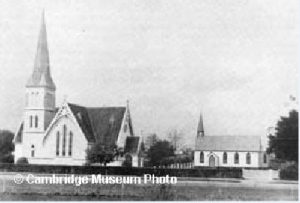
In 1835, Rev Brown established a mission station at Matamata. Then in 1841 the Maori built a chapel at Maungatautari. One hundred years later in September 1941 an oak and a totara tree were planted on the site in Hicks Road.
In 1865 a layman Phillip Whyman held services for the Anglicans in the Wesleyan Chapel. It was not until 1871 that the Anglicans obtained section No. 96 and built their own church.
On 11 April 1873 this church was opened and it was used for fortnightly services alternating with the Presbyterians.
David Richardson the architect, supplied the plans, Phillip Cooper’s tender of £290 was accepted, and Major Clare of the Armed Constabulary offered to cut the stone blocks for the foundations.
Originally this church had a steeple, and the bell would have joyously rung out at the first wedding of Benjamin Garland and Sarah Kingdon on 11 August 1873.
Today the building is used by the Anglicans as part of their Community Centre and is the oldest surviving building in Cambridge.
33) Anglican Church 1881
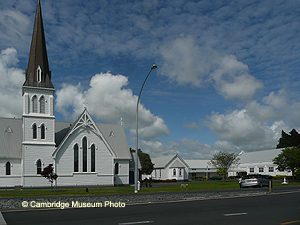
The current church was built in 1881 by William G Connolly, from the plans of Thomas Mahoney, for £1,570. And it was said that Rev William Willis checked each piece of timber, rejecting anything that was not heart Kauri.
The whole town had a holiday when it was consecrated on the 31st August 1881.
The copper spire on the church, reaching 107 feet, is not just an ornament. It contains a peal of six bells tuned in the key of F which are still hand rung on Sundays and special occasions by a guild of bell ringers. The bells weigh 30 cwt and were installed in 1884 at the cost of £360.
The first resident Vicar was Rev William Willis who arrived in 1878 and stayed for 34 years. Many beautiful stained glass windows have been added to the church as memorials, one such window in memory of Archdeacon and Mrs Mary Willis.
The first wedding in this new church was between Thomas Napoleon Peek and Sarah Ann Robertson on the 11th March 1882.
34) Anglican Parish Hall
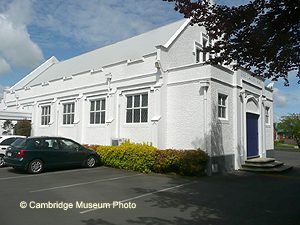
The idea to build a Peace Memorial Hall was first mooted after World War One but there was not enough money at that time.
The Ladies Guild took up the challenge and by 1931 they had £2,000 in hand. In August 1931 Mrs Sarah McCullagh laid the foundation stone with a silver trowel – the handle made out of one of the old churchyard cypress trees. The plaque is inscribed “A.D.M.G.” (To the Greater Glory of God), with the Cross of the Lord over the Cross of St Aidan, “31.8.31”.
The local building firm of Speight Pearce Nicoll and Davys did the work for £2,160 in reinforced concrete with a roughcast exterior, ornamental panels and buttresses. The windows are diamond shaped leadlights and above the front door on the spandrel is designed the Arms of the Diocese and St Andrew’s Cross on shields. There is a front vestibule, open ceilings, stage, supper rooms and lounge.
His Lordship the Bishop of Auckland was presented with a gold inscribed key by the architect Mr T S Cray, to open the hall.
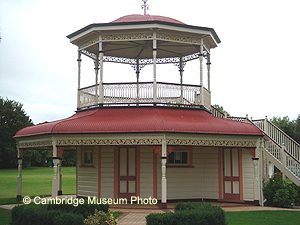
This double storey Band Rotunda must be unique. It is not known where there is another two-storied octagonal rotunda in New Zealand .
In 1910 the Leamington Recreation Reserve was on the Town Belt – on the corner of Pope Terrace and Bracken Street. The Leamington Domain Board decided to plough and roll the reserve and erect a pavilion with dressing room and tea room, and band rotunda on top.
Chas Reid was the architect and the lowest tender from William Hogan of £255 was accepted.
The octagonal pavilion, 18 feet in diameter, is built of heart kauri and totara with ornamental cast iron friezes, brackets and top storey balustrade. The turned posts are kauri and there is a plaster patera from which radiates a tongue and groove ceiling. There is a lead floor in the upper storey with sufficient camber to let the rain run off.
Between three and four hundred people were present for the opening on 25th May 1910 when the Member of Parliament, Mr W H Herries did the honours. The band played, there were speeches, the ladies’ committee provided afternoon tea and the young men entertained with a game of hockey.
Mr McNeil moved the pavilion, with the help of a traction engine, from Bracken Street to the Leamington Domain in 1921. It cost £109/16/ – for the removal and £17/10/ – for a new coat of paint.
The Domain Board planted shelter and ornamental trees, the football grounds were laid out and tennis courts were made.
In 1983 council’s suggestion was to demolish the bottom storey and re-site the ‘band rotunda’ in Victoria Square.
Public comment was sought and the Cambridge Historical Society appealed through the “Top Half” TV programme to preserve the rotunda. A deluge of letters was received by Council and it was saved and renovated for $6,000.
In 1992 the Cambridge Historical Society again wrote to Cambridge Community Board asking them to move the rotunda to a more visible position in the Domain to help prevent vandalism. This was done and another piece of Cambridge history saved.
21) Band Rotunda – Cambridge Domain

In 1905 the Cambridge Domain Board, under the chairmanship of John Ferguson, put the idea of a band rotunda into action. An octagonal plan was chosen and ordered from the firm of Glasgow Ironworks. The kit set castings arrived and erection began. John Christie, supervised by architect Chas Reid, was hired as a day labourer and Henry Preece carried out the concrete work.
The base is a retaining wall of concrete, filled in with rubble upon which is laid a cement floor 21 feet in diameter. The ceiling is of reeded kauri. The twelve feet high columns are of cast steel having a palisading between, and ornamented with birds and sunflowers which support a fret bracket containing the musical emblem of a three stringed musical lyre at each side of their heads. The cost was £280.
On 29 January 1908 the rotunda was used for the first time.
65) Bowling Club Pavilion – Cambridge Domain

The Cambridge Domain is the spectacular setting for the Cambridge Bowling Club, and although the club was formed in 1898 the pavilion was built later, in 1914, as the club grew and added a second green.
A B Herrold, an Auckland architect and keen bowler, drew up the plans gratuitously, and Fred Potts, a local builder, completed the building for £350. This two-storey building faces the greens but overlooks the lake and domain. The ground floor consists of the members’ room and kitchen, and upstairs is the club room and a store room. There is a verandah downstairs and a balcony upstairs.
Additions and alterations were carried out in 1938 and again throughout the 1970s.
71) Burns Street House – ‘Whareora’
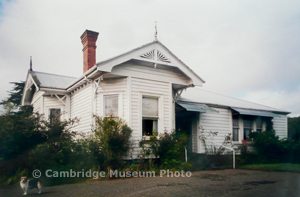
This large Victorian villa on the hill in Leamington was built over the summer of 1901/02 by William Hogan for £842 for William and Mary Rout.
The property has been redeveloped and is now Lauriston Park retirement village.
25) George Calvert’s Chambers – Victoria Street
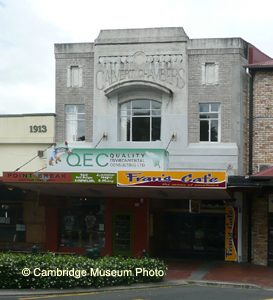
The two storey Calvert’s Chambers was built in 1925 to accommodate two shops down stairs and a number of offices upstairs, by Speight, Pearce, Nicoll & Davys. It is all that remains intact of the original Calvert Building. It is mainly brick with plaster decoration which incorporates the name ‘Calvert Chambers’.
78) 35 Campbell Street House
A very well preserved square villa house with a central gutter and verandah around three sides. It has double verandah posts with wooden fretwork and imposing chimneys.
The soldier of the 3rd Waikato Militia who was granted this section was Sergeant William Fetherstone who had enlisted 8 December 1863 in Dunedin.
The owner who had this house built at the beginning of the 1900s, was possibly Henry Pike whose family enjoyed the spacious property until 1939.
36) Cenotaph – Jubilee Gardens
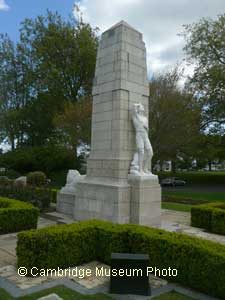
It was not until 1923 that enough money was raised to erect this memorial. The architect, Nigel Walnutt put the Italian marble statue of the Cambridge Soldier, plinth and lion, in the middle of a cross. The sculptor was Richard Gross whose great desire to give something worthy without consideration of cost to himself in labour or expenditure, made it possible to erect such a poignant monument at so little cost. £2,000 was raised and the contractors were A & T Burt of Auckland. It has recorded 74 men from World War One and subsequently 77 men from World War Two, plus a memorial plaque for the Korea and Vietnam wars.
The ANZAC Day service has been held annually in Cambridge since 25 April 1916. Firstly in memory of the Australian and New Zealand soldiers of the Army Corp who lost their lives at the Gallipoli Landing during World War One, and since then for all soldiers.
The memorial was unveiled on 11 December 1923 by Governor General Viscount Jellicoe.
31) Clock – Jubilee Gardens

The Cambridge Clock was supplied by Littlejohn & Sons of Wellington in 1908 and was originally in a tower on the Post Office (much to the annoyance of the Post Master and family who lived in the top storey of the Post Office).
Cracks subsequently appeared in the tower and after the 1931 earthquake this was dismantled. After much to-do the new 13 metre clock tower was built (from designs by architect Harold White) by Speight Pearce Nicoll and Davy for £655.
The original clock was installed and Mrs Edith Priestley (the wife of the Mayor) officially restarted it at 3pm on the 5th October 1934.
23) Court House – Victoria Street
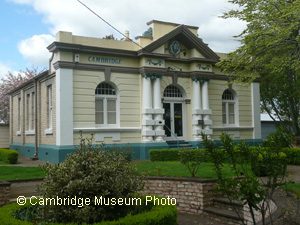
Maori Land Courts were held on this site to determine the ownership of various parcels of land. These court sessions created much activity in the infant town as money, land and goods changed hands.
The old courthouse, prior to 1909, was an army barracks left over from the military days.
The present building was built in 1909 by Fred Potts who completed the work for £1,044:3:4d. It has a Neo-Classic facade with ornate Ionic capitals on the columns at the entrance and the royal ‘ER’ emblem on the pediment. Inside are kauri ceilings, varnished rimu dados and tiled fireplaces.
At its official opening in 1909, Minister for Justice, the Hon Dr Findlay said the building – “symbolised the national struggle our forefathers had to secure for themselves and their descendants liberty and justice. I would like the courthouse to be regarded as a place where the innocent will be vindicated against guilty, the wrong will be punished, and justice and fair play will prevail.”
The Courthouse closed in August 1979 and the building and grounds were bought by the Cambridge Borough Council. The character is still preserved today, but the landscaping has softened the building to make a welcoming place for locals and visitors. It has been occupied by the Cambridge Museum since 1984.
64) Duke of Cambridge Lodge – Empire Street
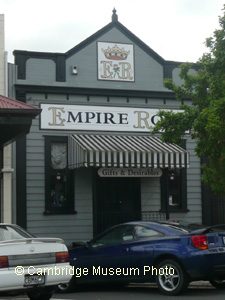
The Duke of Cambridge Lodge was formed in Cambridge in April 1867 (just three years after the town was established) with meetings in the Duke of Cambridge Hotel in Duke Street. It provided social security for members including sickness benefits and a funeral fund.
The Lodge has met in six different localities in the course of its history and up until 1967 met in the Empire Street hall. They bought the site from Mrs Theresa Murphy and the hall was built of matai and totara by William White for £300.
It is a rare wooden building for the centre of Cambridge as a ‘brick only’ by-law had been introduced until a good water supply was connected to all the streets. It was opened 25th August 1908.
This Lodge is now closed but the renovated building is still in use.
68) Grosvenor Street House – ‘Gowanbank’

This was the first two-storey rough cast bungalow designed by architect James T Douce to be built in Cambridge. It was built for Sam Lewis and family in 1914 for £1,572 and adds to the unique character of the Cambridge residential area. And what a stir it must have caused as it started to rise among the surrounding cottages and cowsheds!
Similar designs are dotted throughout the district, all being built within about 20 years.
The soldier of the 3rd Waikato Militia who was granted this one acre section was Henry William Moore who enrolled on 19 June 1866 in Cambridge as a substitute soldier.
13) Hamilton Road – ‘Arnold Cottage’

Just out of the borough on Hamilton Road, this cottage is on its original fifty acre Military Grant given to John Arnold in 1866 at the end of his three year military service. The cottage is the last in the line of a progression from tent to raupo whare to cottage – increased throughout the Arnold family’s lifetime as more children were born.
Maria Arnold, John’s wife, grew sweet peas around the cottage from seeds she had brought from Australia in 1864. She also helped to run the Butchery on the Triangle Corner in Cambridge while John fattened cattle and grew oats. They raised six children and St Andrews Church bears a stained glass window to the memory of John and Maria Arnold.
69) Hamilton Road House – ‘Kelvin’

This square house was built about 1885 for John Ferguson and family on 2½ acres of land. It has a central gutter roof and double hung square bay windows with panelling beneath. The verandah roof is concave and has ornamental fretwork and hexagonal verandah posts. Originally it had four rooms with a central passage and a lean-to out the back.
John Ferguson & Sons ran a coach building business in Lake Street and the house remained with the family until 1955.
The soldier of the 3rd Waikato Militia who was granted this one acre section was Joseph Pratt Hamlin who enrolled on 9 January 1864.
26) Old Legal Chambers – Duke Street

William Francis Buckland – Mayor, Barrister, Solicitor, former M P and daffodil grower, had this two-storied brick building erected for his Legal Chambers in 1899.
It was one of the first brick structures in Cambridge (if not the first) with a classical facade and Corinthian capitals. A solid, practical building, originally with a heavy parapet on top of the facade and two front entrances.
In 1905 the rear part was added to accommodate the Waikato (Cambridge) Independent newspaper’s printing plant, while their editorial offices occupied the downstairs of the building.
Sam Lewis and Henry Dallimore bought the building in 1912, continuing the legal practice. Peter Lewis joined the firm and moved from the building in 1962, while in partnership with David Jecks. Chris La Pine decorated the premises in 1989 and moved his physiotherapy practice into the building, giving it a new lease of life.
88) Lockup – Victoria Street
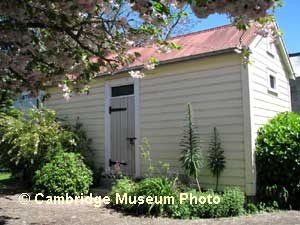
The two-cell lockup now behind the Museum was built in 1905 and later moved from behind the Police Station. When they were built, the Waikato Independent reported – “The cells are well lighted and ventilated and there is nothing to complain of on that score, at any rate. A useful cupboard and handy writing desk have been placed in the passage for the use of the police and solicitors.” Mr F A Marcroft was the builder of this lockup – the old one “still in an excellent state of preservation” was converted into stables for the policeman’s horse.
This building is used at present as storage for the Cambridge Museum.
74) Masonic Hotel – Duke Street
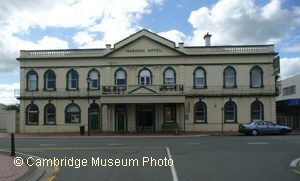
This hotel was built originally of timber in 1866 for Archibald Clements; rebuilt and enlarged with shops and billiard saloon in 1877; then destroyed by fire and rebuilt in 1912 in its present form – colonial but with a classical façade. It was built for £4,100 by Fred Potts and his subcontractors Messrs Speight, Curtain, McVeagh & Palmer. These were the days when the tariff was 8/- per day and 2/- bought a meal.
The Waikato Independent newspaper recorded – “The entrance hall is wide and roomy and there is a handsome staircase with stained glass windows overhead which affords effective diffused light. Upstairs has 24 bedrooms and a lounge which leads to the balcony.”
There is curved cast iron work on the verandah and it was one of only two buildings left in Cambridge with original iron verandah posts which had ornate Ionic capitals, until New Zealand Historic Places Trust advised that the owners could replace the ornate posts with the current ones. It is the only building in Cambridge with a balustrade.
12) Maungatautari Road, House and Stables – ‘Trecarne’
The Reynolds family came to New Zealand from Cornwall, England in 1868. William and his wife Elizabeth had this kauri villa built in 1877 and at that time it could be seen from across the river in Cambridge. The architect was R Keals & Son and the builder Mr James.
It has solid concrete foundations and the walls were filled with pumice for insulation – emptied when electricity was connected. The original heating was the coal range and four open fireplaces.
Trees were a passion for their son Richard, who later took over the property and some beautiful specimens still grace the property.
The wooden stable/barn has a steep gabled corrugated iron roof with a louvered ventilation lantern. A lean-to has been added at a later date.
83) Monavale Homestead – Monavale

Under the architect A B Herrold, (who also designed the Town Hall) William Hogan started building the Monavale Homestead in May 1910. The owner, Channing Buckland, had just returned from America and wanted his house designed along the lines of President Teddy Roosevelt’s ‘Sagamor Retreat’.
The house was set on the same site of the original Monavale Homestead, built by E B Walker when he started draining and farming activities in 1866. His love of trees was continued with Canadian oaks added to the English varieties.
The grand opening in December 1910 was the start of many meetings and social gatherings held in this spacious two and a half storey kauri homestead.
27) National Hotel – Lake Street
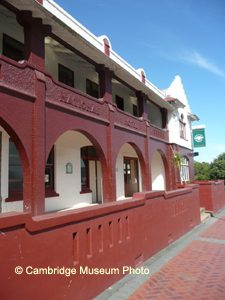
The National Hotel is a well known landmark in Cambridge. Starting life as the ‘Alpha Hotel’it was built for Robert Kirkwood who obtained a Publican’s Bush Licence in 1867. Robert, who has a nearby street named after him, was a Private in the 3rd Waikato Militia and a member of the Cambridge Cavalry Volunteers. This acre section was his militia grant.
The present building was erected in 1912 after a disastrous fire razed the old wooden building to the ground. The architect was J Currie and the builder Fred Potts.
And the Samples Rooms beside the hotel are not for sampling the brew but were used by travelling salesmen to display samples of their wares.
66) Post Box – Victoria Road
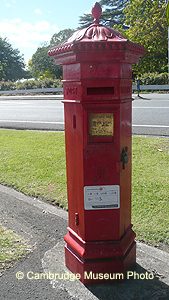
The red iron, Victorian pillar-styled letterbox on the corner of Victoria and Hamilton Roads was built by P & D Duncan in Christchurch and installed about 1898. It has stood on this corner ever since. At that time it cost between £9:10:- and £10:10:-. There are not many of these old letter boxes still in use and the insignia VR makes this one very special.
28) Post Office – Victoria Street
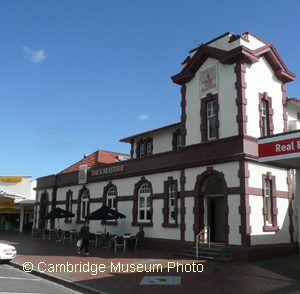
It was a gala occasion on 15 February 1908 when the Prime Minister (Sir) Joseph Ward, came to Cambridge and opened the new Post Office. It was built for £2,964 by William G Care (although a Post Office had been operating in Cambridge since 1864), and the grill over the right archway has the insignia of King Edward VII.
In 1936 more additions were made by the building firm of Speight Pearce Nicoll & Davys for £4,500 and the archway grill erected for King Edward VIII. However, Edward, after a short five months reign, abdicated for the love of Mrs Wallis Simpson and was not crowned King.
These grills probably make the Cambridge Post Office unique.
The square base of the clock tower can still be seen on the right of the building – the tower had developed cracks by 1931 and was dismantled after the Napier earthquake. The clock was later re-sited at Jubilee Gardens. The Post Office was split into three corporations in 1987 – NZ Post, Post Bank (now ANZ) and Telecom.
87) Presbyterian Church – Victoria Street
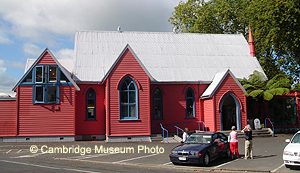
In 1877 the Presbyterians built “an elegant little structure with ornamental spire in Victoria Street.” So said the Waikato Times of the day. This first church was moved to the eastern side and served as a hall until removed to make way for the Peace Memorial Hall in 1922.
The foundation stone of the present building was laid on 2 March 1898 and was opened three months later on the 22nd June. It was built by J Lye & Sons from designs by architect, Mr E Bartley, for the total sum of £813/06/11.
A typical New Zealand Gothic style in kauri and rimu, this Victorian structure was built to comfortably seat 210 parishioners. It was the first public building in the district to be illuminated by acetylene gas.
Today the Cambridge Presbyterian and Methodist churches have joined to be the Trinity-St Pauls Union Parish Church in Queen Street.
The Presbyterian building had been turned into a craft shop and was known as the ‘Pink Church’, or Cambridge Country Store, which operated from 1986 until mid-2016. The Pink Church was then purchased by the Good George Brewing Company, where it opened its doors to the public as the Good Union Hotel in early 2017 after repairs and maintenance, including painting the iconic pink to white.
In 1983 the Memorial Seat made from Hinuera stone was erected beside the church, to commemorate over 100 years of worship by the Trinity Presbyterian congregation in Cambridge.
32) Primary School – Duke Street
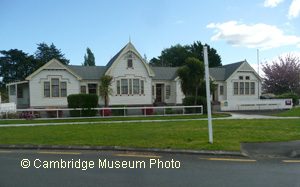
The three R’s resounded throughout Cambridge at first from the Ten Star Redoubt in Fort Street, then from the old military hospital. This was originally in lower Duke Street and moved to this present site and converted in 1869.
As the town grew so too did the school, and additions and alterations have been carried out over the years.
The four gables seen today were built in 1879, 1881, 1886 and 1904. Another acre of land was bought in 1909 to provide a bigger playground.
The High School was started along side the primary school in 1883 and in 1909 the Technical School was opened in Victoria Street, next to the Courthouse. In 1927 the Dental Clinic was built and in the same year the High School moved to Clare Street. The High School then split from the Intermediate School and relocated to Swaynes Road in 1963.
75) 88 Princes Street – House

This square villa has three front doors and double hung windows on the side walls. The roof and the verandah (which goes around three sides) are all in one and it has a plain chimney.
72) 68 Queen Street – House
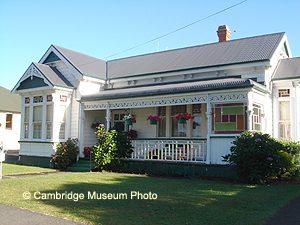
A good example of an early 20th century Victorian Bay Villa house, this very spacious home has original wrought iron fretwork under a bull nose verandah, ornate turned wooden verandah posts and coloured glass.
It has a single gable with square bay window and pediment with ornate fretwork, the same pitch as the gable.
The soldier of the 3rd Waikato Militia who was granted this one acre section was Thomas Naylor Crankshaw who enrolled as a substitute soldier 6 April 1866 in Cambridge.
Manson Edward Gardner commissioned Chas Reid as architect who accepted the lowest tender of £576 from Frank Marcroft for this ten-roomed residence in 1907.
29) Former Returned Services Association Building – Empire Street
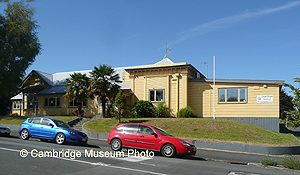
(This building has been demolished). It was the second oldest building in Cambridge and was originally built for the Waikato Farmers’ Club in 1877. The architect was Messrs Keal & Sons, and Mr James’ tender of £615 was accepted for the building.
The original kauri building was 80 feet long and consisted of a library, lecture room, a smoking room and two committee rooms. It was comfortably furnished at an overall cost of £800 and opened 20 October 1877.
Monthly meetings were held with topics of wheat, drainage, trees etc., and the adjoining grounds were used for agricultural shows.
It was sold to Tom Wells for £1,355 as a private dwelling, ‘Oakleigh’, in 1881 and he added the north gable. Speight Pearce Nicoll and Davys, a local building firm, bought the building from the Wells family with the intention of turning it into flats. Instead they generously donated the building to the RSA for their club house in 1941.
This building is now in private hands.
The 3rd Waikato Militia soldier who was granted this acre of land was Andrew Gray who enlisted 4 July 1865 at Cambridge.
37) Salvation Army – Duke Street
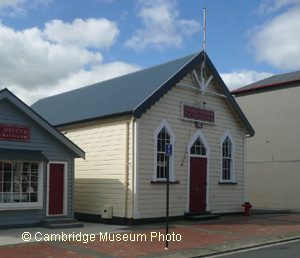
‘The Sallies’ bought the Oddfellows Lodge building in Duke Street in 1893. They sold this in 1907 to Mr A E Harris who used it as a storeroom, and built themselves a new barracks in Duke Street.
The new building, with arched totara windows and scalloped barge board, was built for just over £400. It has rusticated matai weather board and kauri base boards, and was built by day labour from the plans of Melbourne architect, Brigadier E Saunders.
The Army has been in Cambridge since 1889, at first under the charge of Captain Wood, and the building is still used by the Salvation Army.
The soldier of the 3rd Waikato Militia who was granted this one acre section was James Brien who enrolled 14 December 1863 in Tasmania, Australia.
67) 74 Shakespeare Street – House
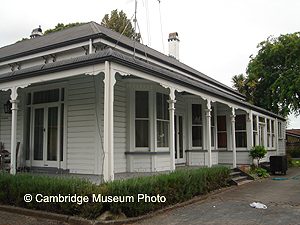
Now hidden behind the trees, this square villa, when built in 1902 for Joseph J Collis, had expansive views from its terrace. Originally it had bull nose verandahs on three sides, square verandah posts surmounted with ornamental fretwork and central gutter roof.
The soldier of the 3rd Waikato Militia who was granted this one acre section was John James Woods who enrolled 18 December 1863 in Dunedin.
38) 109 Shakespeare Street – Cottage
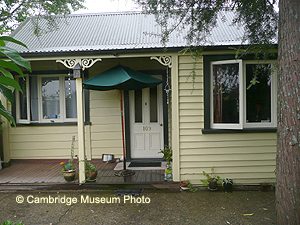
This is a kauri cottage built about 1879 and one of two privately owned cottages in Cambridge on the New Zealand Historic Places Trust list. It is believed that the front of this cottage, when occupied by Benjamin and Sarah Garland, was the General Store and Post Office with ‘lean to’ living quarters added on the back.
The soldier of the 3rd Waikato Militia who was granted this one acre section was Robert Glover who enrolled 9 December 1863 in Auckland.
70) 2 Thornton Road House – ‘Orongo’
This is a beautiful stately home on the former of Victoria and Thornton Roads. The name ‘Orongo’ is taken from the district in Thames that William Earl, the first owner came from.
In 1874 a block of land on Thornton Road to Princes Street was owned by George Henson. His occupation was a gardener and we can thank him for donating one of the ornamental trees in Jubilee Gardens. In 1902, through the land agents Souter & Co, he sold off the corner section to William and Eleanor Sarah Earl. The house was started on 8 August 1902 and the architect was W J Wrigley of Auckland.
Mrs Earl nee Pulham came from Auckland where she had trained as a nurse. After qualifying she did private nursing and then, in 1896, ran a sanatorium in Duke Street, Cambridge. She married William Earl, who had been one of her patients, in 1899.
At ‘Orongo’ it became an annual event for the Earls to host a party for the Cambridge Band members and friends on New Year’s Eve. As this was the era of ‘at homes’, many afternoon visitors must also have called and been entertained in the drawing room. This is a zinc lined room by the front door.
William Earl died in 1907 and Eleanor Sarah remarried in 1910 to David Murray of Wanganui. During the influenza epidemic, just after World War One, Sarah led a band of willing helpers in the Town Hall where a temporary hospital had been set up.
David Murray died in 1924. Then, during the 1930’s, Sarah turned the front (Victoria Street) end into a flat which was let to Mrs Gascoigne.
The land on which ‘Orongo’ stands included residential sections on Thornton Road, (sold to Mr Price in 1952) as well as today’s kindergarten. The Cambridge Croquet Club began on the Kindergarten site in 1906 and Mr Murray donated this to the club in 1917.
Eleanor Sarah Murray died 11 February 1950 at the age of ninety and having no children of her own she left the house to her sister, Mrs Bear. In turn, in 1953 her daughter Hilda inherited it and sold to Mr and Mrs Armistead in 1954. Mrs Blackie bought it in 1965 and then Mr and Mrs Kirkby moved from Maungatautari and lived there from 1967.
The original owner, George Henson, must be pleased with the work carried out in the garden as the house has always been a credit to Cambridge. Among the trees in the garden is a Magnolia listed with the Protected Trees.
76) 18 Thornton Road – ‘Potts House’
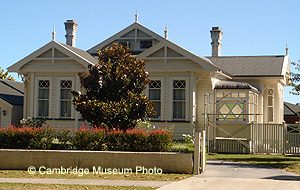
This house is a double-gabled Victorian bay villa with coloured glass fan lights and very tall chimneys. It was built by a Cambridge builder, Fred Potts, as his family home, about 1909.
Fred built many Cambridge homes and businesses including the butter factory at Hautapu, the Cambridge Club, Courthouse, Masonic and National hotels and the Cambridge Bowling Club pavilion – thus adding much to the character of Cambridge.
35) Town Hall
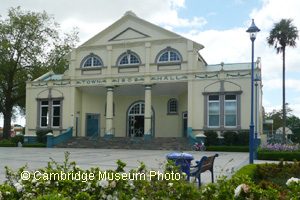
Controversy reigned when the Town Hall was first mooted on the site of the sale yards. After all the sale yards were the hub of any rural town – close to the hotels and business area.
The Mayor of the time was William Francis Buckland, a formidable character who was determined to push Cambridge into the 20th century. He resigned when the council refused to accept a tender just over the agreed loan of £5,000. He returned the next day with the support he needed.
The hall was designed by architect A B Herrold and built by Chappell & Woolley with the foundation stone laid 21st April 1909 and the opening ceremony on 14th December 1909.
It is mainly Huntly brick but relieved by gauged red brick on arches and sills, with imposing columns at the front entrance. Incorporated into the Town Hall was the Carnegie Library after a generous donation of £1,000 from the philanthropist, Andrew Carnegie.
For many years the Town Hall was the local picture theatre and in 1927 the Theatre Co spent another £3,000 in refurbishments. In 1918 it was used as a hospital during the influenza epidemic and on the 1st January 1954 Queen Elizabeth 11 and Prince Phillip stopped there for lunch.
Today the area is still the centre of Cambridge, and the park-like setting is preserved for everyone to enjoy.
24) Victoria Bridge
The ‘High Level Bridge’ became the fourth bridge across the Waikato River in Cambridge. The first floated away in the flood of 1875 and the Red Bridge was demolished in 1909. The Victoria Bridge was sent out from Kansas, USA, as a kitset, and erected in 1907 from both sides of the river, meeting in the middle. It is 35.4 metres above the river and created a lot of attention as it was built in 7 months and the first Braced Steel Arch Bridge in New Zealand. The cost was £13,000 and official opening was on 21 December 1907.
It wasn’t long before the motor car superseded the horse and in 1925 the softwood deck was replaced with hardwood and footpaths were added. In the 1960’s the deck was again replaced, this time with reinforced concrete. From selected viewpoints on the river tracks the bridge is a very dominant feature.
30) Victoria Street – ‘Souter House’

This private dwelling belonged to Captain William Souter, a retired sea captain who, in his own ship, carried on trade between Auckland and Australia. He married Sarah in 1862 in Auckland, and they had 3 sons – Joseph, Arthur and Edwin – and 3 daughters – Anne, Violet and Kate.
They came to Cambridge about 1880 and established W Souter & Co.
Joseph and Edwin Souter took over this business in 1888 and became very successful general merchants. They moved into the motor industry and stayed with it until 1961. (Souter & Co imported the first Ford Motor Car into the Auckland Province in 1908.)
Souter House was designed by Mr James and built about 1881 of rimu and kauri, with 13 foot studs, small pane windows and finials – which are still intact. As the family, grew additions were made to the house.
In 1991 it was converted to include a restaurant and now, with new owners, it has become a part of the Cambridge business scene.
The soldier of the 3rd Waikato Militia who was granted this one acre section was Theophilus Galway who enrolled on 1 September 1863 in Melbourne Australia.
Protected Trees near Souter House are a Coral tree, Black walnut and Copper beech. The Japanese Momi Fir (which looks like a Christmas tree), was planted in 1905 and is considered the best specimen in the North Island.
81) 116 Victoria Street House

This Victorian bay villa has a corner entrance surmounted with a pediment, and two short verandahs. The roof and verandah are all in one. Originally it was sited on the corner section but has since been built out.
It was built for James and Agnes Bryce and family in 1911.
The soldier of the 3rd Waikato Militia who was granted this one acre section was Benjamin Booth who enrolled 22 December 1863 at Howick.
79) 150 Victoria Street and King Street House
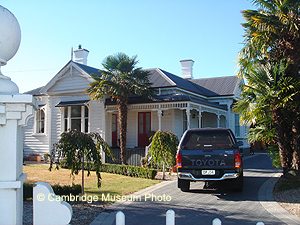
A very early Victorian bay villa with bull nose verandah and ornate posts and fretwork. It has a single square bay window with hood and small pediment. Also a glass panelled front door with stained glass skylight.
It was built in 1884 for James Paton Thomson.
The soldier of the 3rd Waikato Militia who was granted this one acre section was Edward Gaymer who enrolled on 25 September 1863 in Christchurch.
22) 197 Victoria Street – ‘Valmai’

This grand kauri home was built in 1901 for James Hally and family, from the plans of architects Mitchell & Watt. It has a beautiful ornate Queen Anne style with many gables, bay windows with coloured glass, fretwork and tall chimneys. And inside, still intact, pressed zinc ceilings, tiled fire places and painted glass windows in the entrance hall.
‘Valmai’ has seen its days as a private home, boarding house, surgery, motel, rest home and school dormitory.
Conservatory
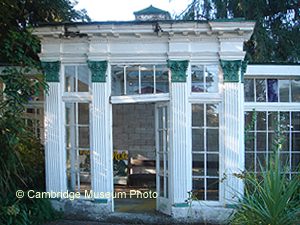
The Conservatory in the grounds of ‘Valmai’ was built mainly of kauri in 1881 at Major Wilson’s ‘Waterside’ residence in Wilson Street and later in 1966 it was moved to ‘Valmai’ where it was renovated. Ornate corbels, capitals and coloured glass windows, make this a very unique structure even though the bricks have been replaced by concrete blocks.
Protected trees which were planted here at ‘Valmai’, at the beginning of the century, include a bunya bunya, rimu, oak, beech, lime and spruce.
20) Water Tower – Hamilton Road
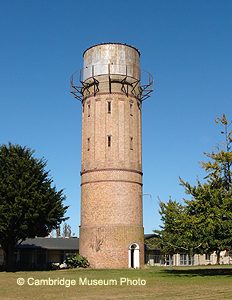
This water tower is in front of Resthaven Resthome on Payne Park and was built in 1903 for £1,077. It closed twenty-three years later. The contractor was J J Holland, and George Russell Fellows was the brick layer. Robert Morse helped to build the tower and with his horse ‘Darkie’, raised the bricks by pulley, 80 feet to the top. Water was pumped from the Moon Creek springs (beside the Gasworks) to the 20,000 gallon tank on the top of the tower.
73) 62 Williams Street – ‘Tregarthen’
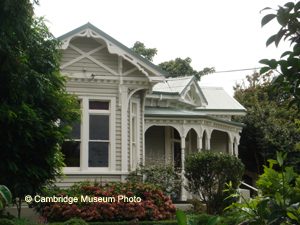
Built in 1903 for Edward and Margaret Wilkinson, with Montalk as architect and Potts and Hardy the builders, its style is along the lines of Queen Anne architecture with three large gables and bay windows. It has an elegant corner entrance with turned verandah posts, solid door and window panels. Also three imposing chimneys which service six fireplaces decorated with tiled surrounds.
The 3rd Waikato Militia soldier who was granted this acre of land was John O’Sullivan who enlisted 1 August 1863 in Melbourne Australia.
86) 32 and 36 Wordsworth Street Houses

These Victorian villas are both ornate houses built in 1905 – number 32 is a square central gutter style and number 36 is a bay villa with return verandah. Both have ornate wooden fretwork, bay windows, gables, ornate chimneys and bull nose verandahs.
The 3rd Waikato Militia soldier who was granted this acre of land was Samuel Hampton who enlisted 20 October 1864 at Cambridge.
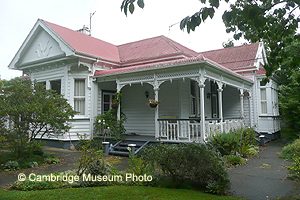
Disclaimer:
While all due care has been taken to verify information contained on this site, the Cambridge Museum accepts no responsibility for any errors, omissions or misrepresentation.
Copyright © 2003 – Cambridge Museum – All Rights Reserved.


